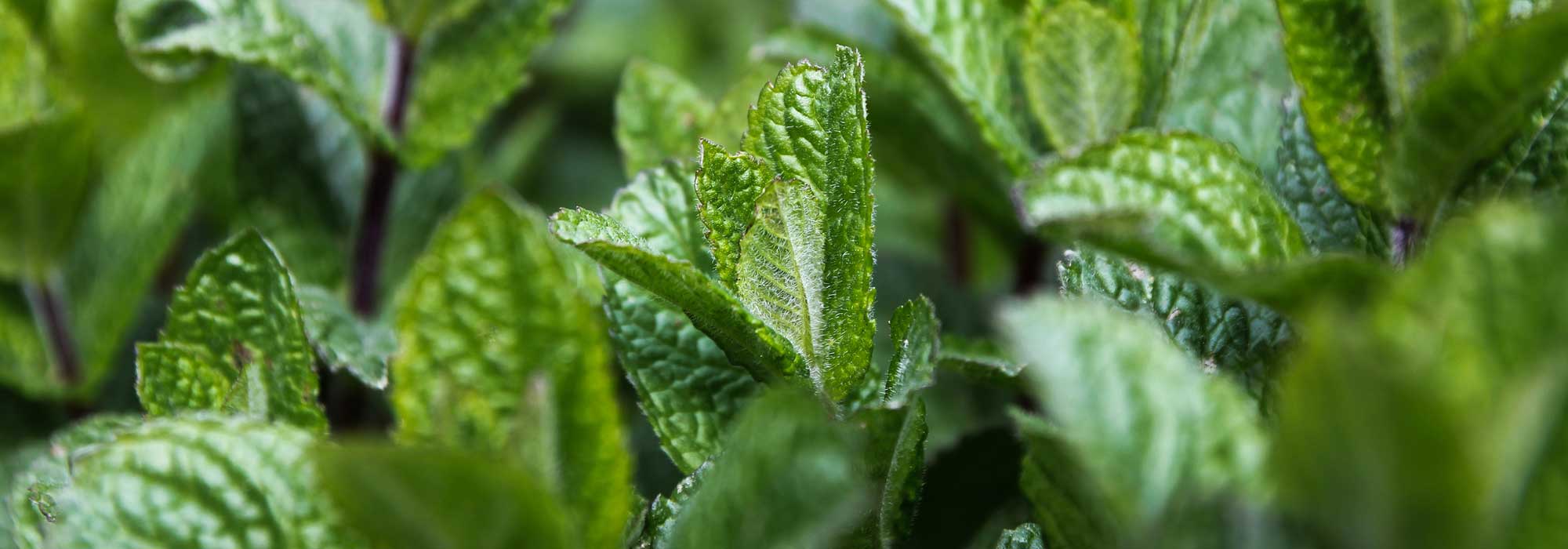
Mint: planting, growing, propagating
Contents
Mints in a nutshell
- Mint, or rather mints, as there are many varieties, are perennial, aromatic, and medicinal plants with a refreshing aroma.
- They can be grown in the garden or in pots, in full sun or partial shade, in rich, fertile, and fairly cool soil.
- They are easy to care for, and their maintenance only involves limiting their spread.
- Their leaves are harvested from April to October and are used to make tea, flavour dishes, desserts, and drinks.
A word from our expert
Mint is not difficult to grow, it grows and spreads easily in the vegetable garden, which is both its main quality and its main drawback! Indeed, mint tends to become invasive, especially if the soil and exposure suit it. However, not all species are equally colonising: the deer mint, for example, behaves more modestly!
Easy to grow, mint is also known for attracting beneficial insects and dissuading unwanted insects from the garden, such as aphids, ants, and certain rodents. In my garden, I grow it under my fruit trees, and during flowering, I can observe many beneficial insects like hoverflies, tachinid flies, etc…
The species and varieties of mint are numerous and each offers different scents and uses. Among the most common in cultivation, we distinguish peppermints, spearmints, and round-leaved mints.
In cooking, the use of fresh mint is quite uncommon, yet it can enhance the flavour and freshness of many dishes, from tabbouleh to chocolate mousse! Mint harvested at the right time and then dried is also a true delight in the heart of winter!
Description and Botany
Botanical data
- Latin name Mentha spp.
- Family Lamiaceae
- Common name Mint
- Flowering Perennial
- Height 5 years
- Exposure Sun - Partial shade
- Soil type humus-bearing, draining, cool, non-calcareous
- Hardiness -15°C
The mints are native to Europe and Asia and, more generally, to temperate zones. The genus name Mentha is derived from Greek mythology. Indeed, we find the name Menthé (or Mentha or even Mintha), which is the name of a nymph who falls in love with Hades, the lord of the Underworld. Persephone, Hades’ wife, takes revenge on this relationship and transforms Menthé into a plant.
The French common names for mint were numerous and varied according to the regions, uses, and species of mints. However, the root “ment” was often present; another name commonly given was “balm” for its use as an ointment.
From popular knowledge to beliefs and superstitions, mint has accompanied humanity through the centuries. It was used for its calming or stimulating properties, aphrodisiac and refreshing qualities, and in certain rituals for its purifying properties.
Mints (Mentha spp.) are aromatic herbaceous perennials from the Lamiaceae family. They measure between 10 and 90 cm in height depending on the varieties and growing conditions. The diversity of wild and cultivated species is significant, with no fewer than 18 species and a multitude of cross-breeds. Among cultivated species, the four most common are:
- Peppermint (Mentha x piperata)
- Spearmint (Mentha spicata)
- Round-leaved mint (Mentha rotundifolia)
- Pennyroyal (Mentha pulegium)
Botanical aspects vary, but they all share a common feature: they produce erect stems, branched, more or less villous, with a square section, a typical character of the Lamiaceae family. The stems are green (reddish for peppermint) and bear round to ovate lanceolate leaves, dentate, more or less crinkled, and strongly aromatic. Flowering occurs from June to September. The flower spikes rise and bear spikes, heads, or inflorescences in whorls, with small pink-purple flowers. They require the presence of insects to carry pollen and perform pollination. The fertilised flowers develop into small seeds.
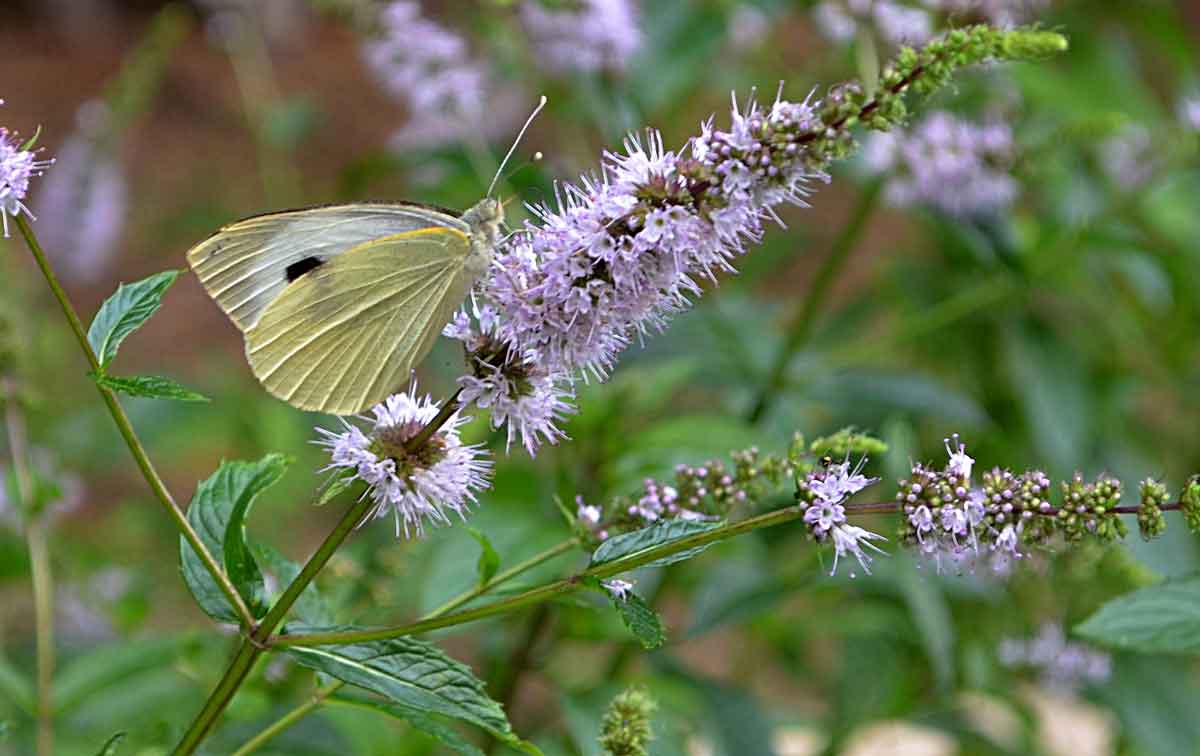 Mint in bloom, particularly melliferous, attracts a wide variety of insects[/caption>
Mint in bloom, particularly melliferous, attracts a wide variety of insects[/caption>
Read also
Succeeding in growing parsleyThe main varieties of mint
There are many varieties of mint, the most well-known being spearmint, peppermint, pennyroyal, and round-leaved mint. Depending on the variety, the leaves will offer you a whole range of fragrances.

Peppermint – Spearmint – Round-leaved mint – Pennyroyal
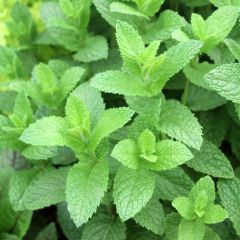
Mentha spicata Nannah
- Flowering time July to September
- Height at maturity 50 cm
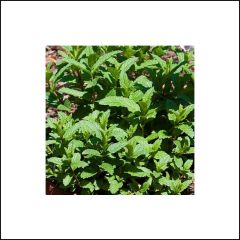
Mentha spicata Wintergreen - Mint
- Flowering time July to September
- Height at maturity 50 cm
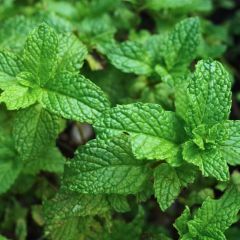
Mentha espagnole
- Height at maturity 50 cm
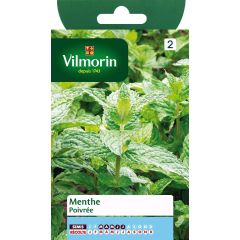
Mentha piperita
- Flowering time July to October
- Height at maturity 50 cm
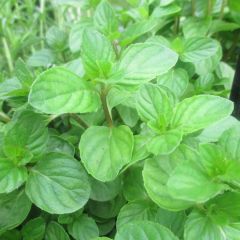
Mentha piperita chartreuse
- Flowering time September, October
- Height at maturity 50 cm
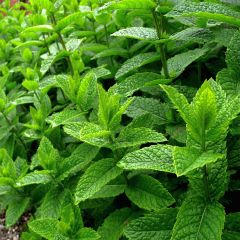
Mentha piperita officinalis Alba - Mint
- Flowering time September, October
- Height at maturity 50 cm
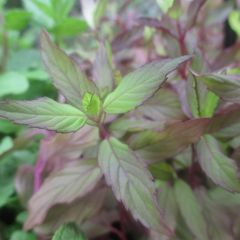
Mentha rotundifolia Ananas
- Flowering time August, September
- Height at maturity 50 cm
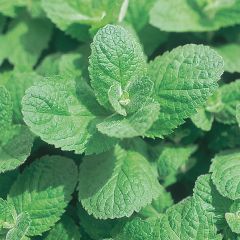
Apple Mint
- Flowering time August, September
- Height at maturity 50 cm
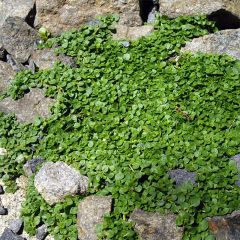
Mentha requienii - Mint
- Flowering time August to October
- Height at maturity 5 cm
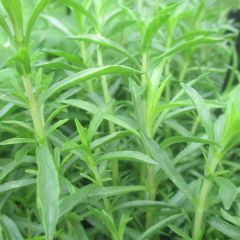
Hart's Pennyroyal - Mentha cervina
- Height at maturity 50 cm
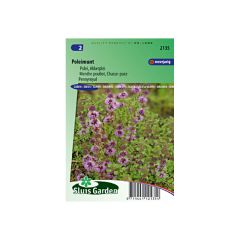
Mentha pulegium seeds
- Flowering time August to November
- Height at maturity 50 cm
Growing Mint
Mints are perennial plants that are grown for two or three years because, beyond that, they tend to exhaust themselves and become less productive. Choose carefully the location where you wish to sow or plant them: mint spreads very quickly due to its running roots. You can also grow it in pots, which allows you to control its expansion.
Soil and Exposure
Mints thrive in all exposures, but it is best to place them preferably in partial shade. They prefer humus-bearing, well-draining, and cool soils, even slightly moist and non-calcareous. If your soil is poor, add well-matured compost in the previous autumn, by scratching it in to a depth of 5 cm, after properly loosening the soil.
Mint is established, whether from seeds or young plants, in previously loosened and well-weeded soil. To do this, loosen the soil using a broad fork or a spading fork, taking care to remove any weeds and adventive plants.
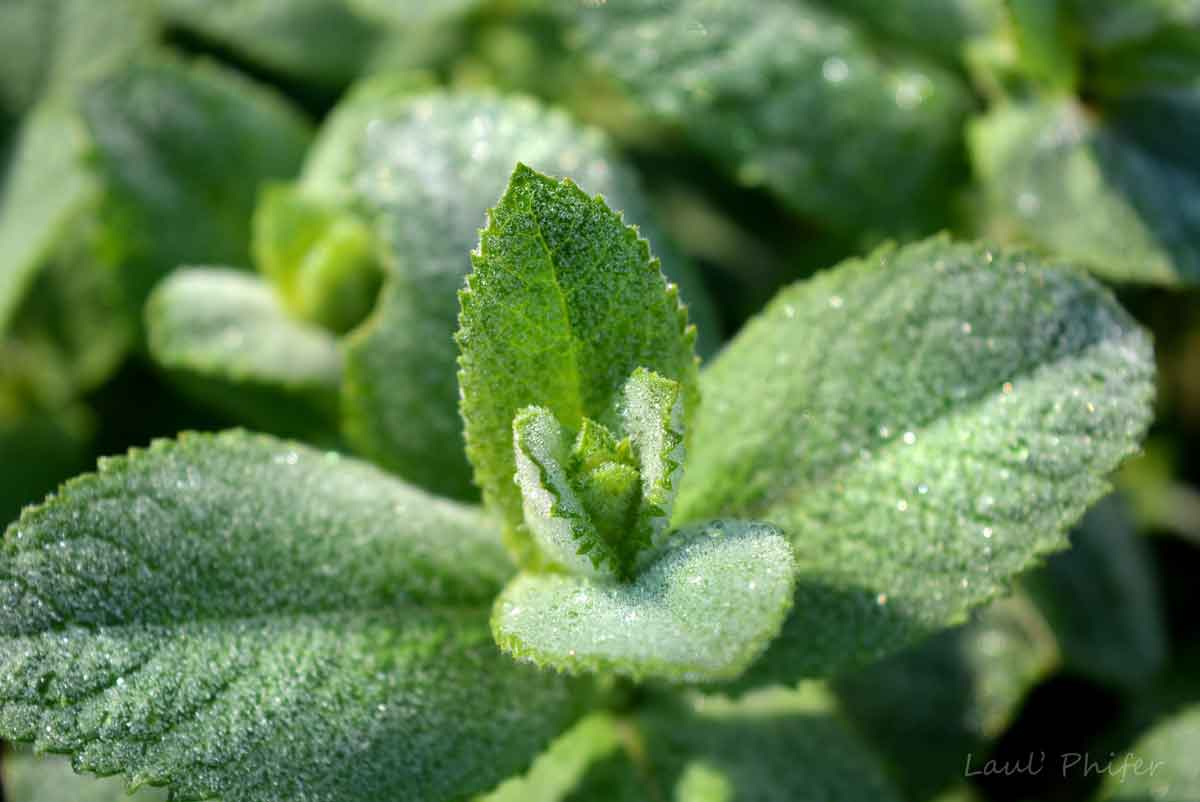
Maintaining Mint
Maintaining mint is simple:
- Water frequently during hot weather and in drying soils.
- After flowering, cut back the plants to encourage new shoots.
- Control its expansion once a year if it becomes too invasive in your vegetable garden or herb garden.
Companion Planting with Mint
Mints pair well with fruit trees, benefiting from the coolness of their crowns and not negatively affecting fruit yields. On the contrary, mints are useful; during flowering, they attract many beneficial insects that will act positively on pests of fruit trees.
However, I do not recommend mixing it with vegetable beds, except when grown in buried pots placed in strategic locations such as near carrot rows to deter carrot flies or between cabbages to try to dissuade cabbage whites from laying their eggs under their leaves.
Read also
Leaf beetlesPlanting mint in the garden
Mint from buckets should be planted in spring, ideally in April and May, although it is possible to plant them later. There is no ideal exposure for mint as they thrive in all exposures, with a slight preference for partial shade.
Planting in open ground
When planting in open ground, allow for an spacing of 30 cm between two clumps of plants. As with sowing, planting should be done in loosened and weeded soil. To plant:
- Dig a hole that matches the size of the young plant, enriching with well-rotted compost if necessary.
- Place two to three mint plants in each planting hole.
- Fill the gaps with soil.
- Water for the first time. Rainwater warmed in the sun is preferable.
Its location in the vegetable garden
I do not recommend planting mint in the middle of vegetable beds, unless it is contained in a buried pot as we have just seen. If you want it to grow more freely (without root barriers), it is wiser to cultivate it in a herb bed or under larger fruit trees.
Potted mint for the balcony or terrace
On the terrace or balcony, mint is easy to grow in a pot. Here’s how to plant and care for it properly.
How to plant mint in a pot?
To plant a mint plant in a pot:
- Place one to two centimetres of clay balls or pumice at the bottom of a pot (with drainage holes) for drainage.
- Fill your pot with universal potting soil that you can enrich with your homemade compost, using 1/3 compost to 2/3 potting soil.
- Transplant one to three buckets of young plants in the centre of the pot (depending on the size of the pot) to form nice clumps.
- Water with a watering can; lukewarm water is always preferable.
Care tips for pot cultivation
To keep your mints healthy:
- Initially, when the plants are young, immerse the pot in a bucket of water for a few minutes once a week (or more during dry periods).
- When the plants have established well, water from the top or soak your pots in lukewarm water in the sun, preferably rainwater.
- As with the vegetable garden, choose a sunny or slightly shaded spot and ensure that the soil does not dry out too much at all times.
If you start with plants purchased from a shop, don’t hesitate to cut half of the stems before repotting the plant. This operation will stimulate your plant to produce new roots and new shoots.
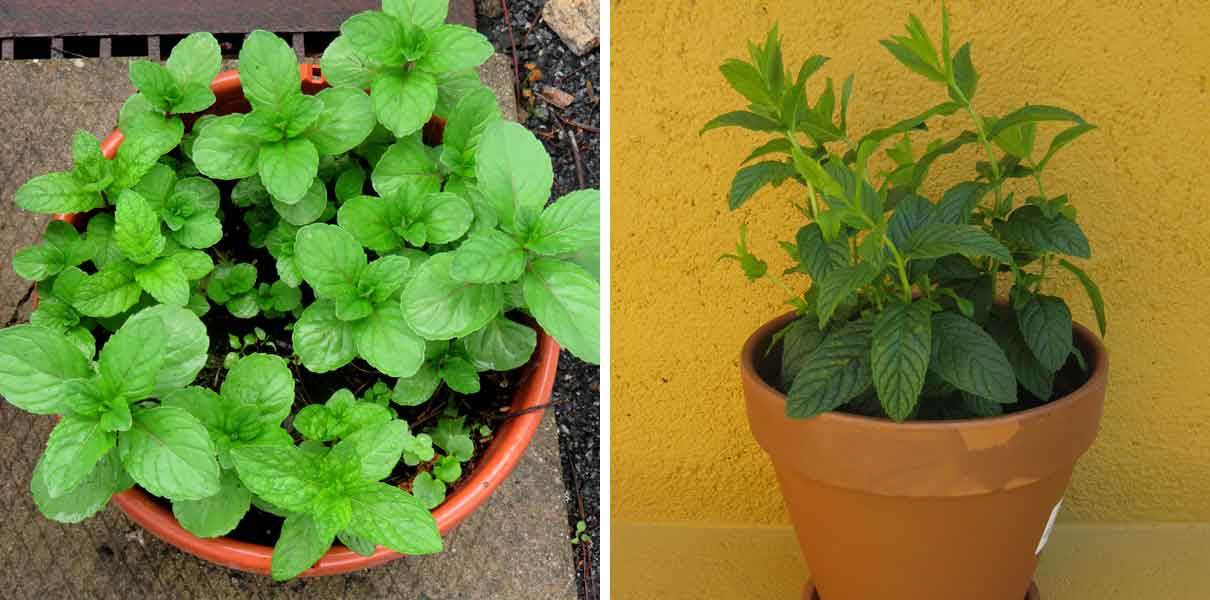 Mint adapts very well to pot cultivation
Mint adapts very well to pot cultivation
Sowing mint
Sowing mints is less common than direct planting; however, it is useful for obtaining rare species and varieties or a large quantity of young plants. Sowing takes place from March to July and can be done in a nursery under cover or in open ground.
Sowing under cover in buckets
Sowing under cover in buckets is done from March to May.
- Fill buckets with special sowing compost.
- Sow the seeds in clusters, with 4 to 5 seeds per cluster.
- Cover with a layer of sowing compost equal to the thickness of the seeds using a sieve (ideally), and lightly press down with your fingers.
- Water lightly using a water sprayer.
- To encourage germination, cover the buckets with a glass. Ventilate during the day by lifting the glass once the seedlings have appeared.
- After germination, thin out to keep only one young plant per bucket.
- In autumn or the following spring, depending on the development of the young plants, transplant them into open ground. Allow 30 cm in all directions between the young plants. Water to keep the soil moist.
Direct sowing in open ground
- Sow very sparsely from mid-May, when the soil is warm enough.
- Cover lightly with fine soil (only 1 to 2 mm).
- Firm down lightly with the back of a rake.
- Water finely and keep the soil moist. After germination, thin out to maintain 30 cm in all directions between the young plants.
Multiplying mint: sowing and cuttings
Sowing your own mint seeds (harvested by yourself) is quite rarely practiced as the species hybridise very easily with one another. However, if curiosity drives you to try, don’t hesitate; you may make some wonderful discoveries! You will then just need to propagate these beautiful creations vegetatively, as we will see with these three techniques.
Repotting the rootstocks
- In spring, the clumps from the previous year are uprooted, and the rootstocks are collected.
- Simply cut sections of rootstocks about 5 cm long with pruning shears. It is preferable to ensure that the rootstocks have some roots.
- Plant them in pots or in the ground at a depth of 5 cm.
- Water to encourage good establishment.
Dividing the clumps
- In autumn or spring, uproot the clumps and divide them into several pieces using a good knife.
- Replant them in pots or in the ground, enriching their new location.
- Water well to help the plants establish.
→ Learn more in our tutorial How to easily divide mint?
Taking cuttings from the stems
- Take several non-floriferous stems about 10 cm long. Remove the leaves from the base.
- Place them in a glass of water filled with clean rainwater (preferably).
- Change the water regularly (twice a week) to prevent mould development.
- After about 1 month, repot the cuttings into pots.
- Plant out in the following spring, in April-May when the risk of frost has passed.
Harvesting, preserving, and using mint
Harvesting Mint
Mint leaves can be harvested as needed from April to October. Choose the largest and undamaged leaves and cut the entire stem to encourage regrowth. Preferably harvest in the morning to make the most of mint’s aromatic qualities.
Mint stems generally do not withstand winter cold, unless the winter is mild, but in that case, their fragrance is significantly diminished. It is possible and even recommended to harvest the stems in summer, just before flowering, dry them, blanch them, and store them for use during the winter months.
Proper Storage
While it is enjoyable to consume freshly cut mint leaves, it is even better to make your own dried mint!
To store mint leaves, dry them on trays away from light until they lose as much moisture as possible. They should be completely dry and crumble easily between your fingers. They are then blanched (separated from the stems) and stored in airtight containers or kraft bags for herbal teas, which should be kept away from light.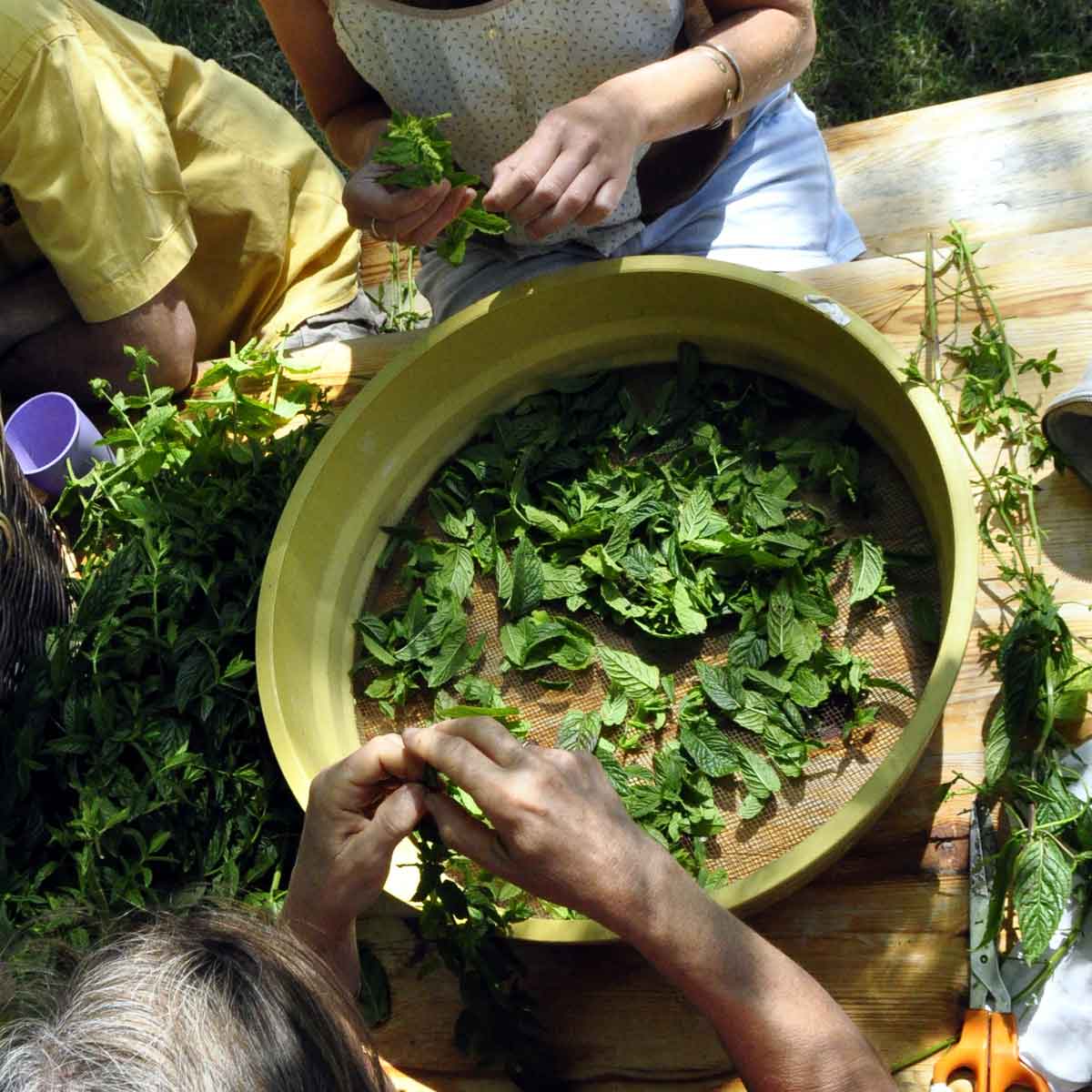
Using Mint in Cooking or Infusions
- Fresh LeavesIn cooking, use them from starters to desserts, to flavour salads and raw vegetables, peas, Lebanese tabbouleh, summer grills, yogurt-based sauces, or fruits. The leaves are also delicious in infusions with hot chocolate or for making your own homemade mint syrup.
- Dried Leaves Dried peppermint leaves can be used to prepare an infusion, taken before or after meals to aid digestion. It is made by adding a pinch of leaves per cup, infused for 5 minutes. This infusion can also replace coffee as a caffeine-free stimulant. Use spearmint leaves (for example, the Nannah variety) to prepare Moroccan mint tea. This tea is made with green tea, such as Gunpowder, and sugar. In the warm season, it can also be made with fresh leaves.
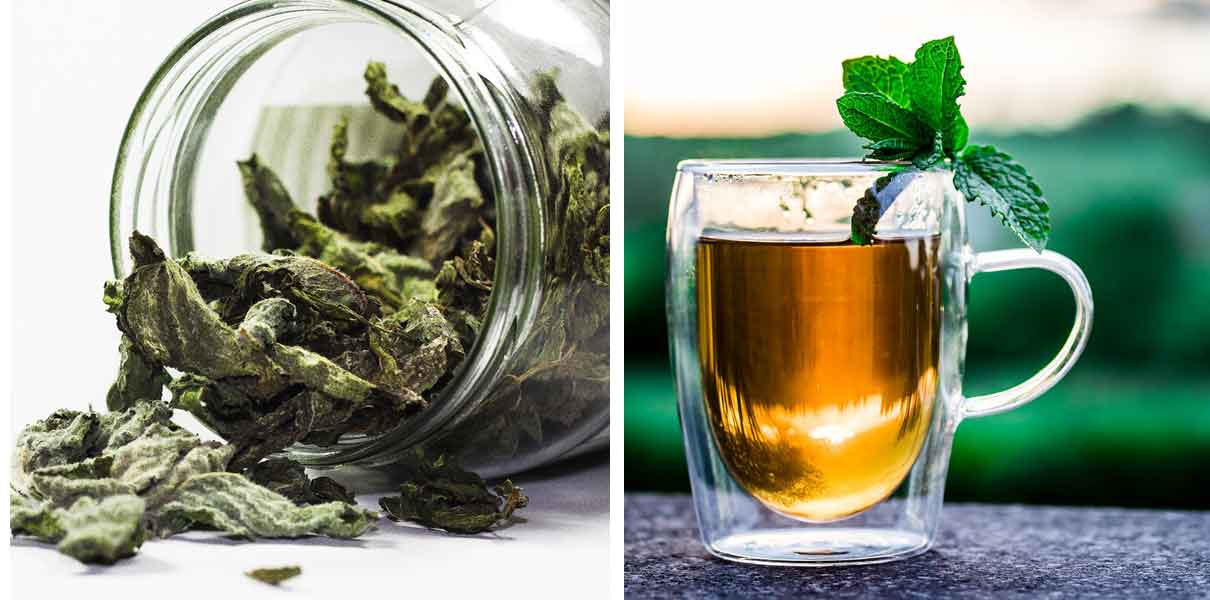
Dried Mint – Mint Tea
The benefits of mint
Mints are refreshing, and we owe this property to menthol, a molecule that triggers this sensation of coolness. Peppermint is the species with the highest concentration of menthol.
Mint has antispasmodic, antiseptic properties, as well as tonic and calming virtues. Mint stimulates digestion, and in this case, it can be used as an infusion of leaves after a heavy meal. The same application can be used to prevent insomnia. Its stimulating properties are also said to be aphrodisiac.
Peppermint essential oil is used for its tonic, antiseptic, and decongestant properties. A drop of peppermint essential oil applied to the temples and along the forehead works wonders for relieving a migraine. Be sure to check the precautions for using this essential oil, as it can be toxic to babies.
Useful resources
- Discover our wide range of mints: many varieties are available as seeds or young plants.
- To go further, also discover the excellent book, Mint Scent by Bernard Bertrand published by Éditions de Terran.
- Discover 6 essential mints
- Find out how to successfully grow mint in pots
- Learn more about mint cuttings
- Discover the recipe for homemade mint syrup
- Watch our video on garden essentials: mint.
- Mint is an ally for your hair! Learn more with Gwenaëlle in Healthy Hair and Well-being Thanks to Your Garden Plants.
Frequently asked questions
-
How to limit the spread of mint in the vegetable garden?
Mints are invasive with their running rootstocks underground. To prevent them from taking over the growing beds, you can sow (or plant) them in a terracotta pot that you bury completely – or leave a few centimetres of the pot above the soil surface. Choose a pot that is large enough, with drainage holes in the bottom, and regularly divide the clumps in autumn or spring.
To allow for a wider growing space while limiting their spread, it is possible to define an area with 20 cm tiles buried vertically.
-
Why are my young plants of mint turning yellow and losing their leaves?
Most of the time, yellowing mint leaves indicate a lack of water. Indeed, mint requires cool, even relatively moist soil to thrive. In such cases, water more regularly with tepid rainwater, install a mulch to retain moisture in the soil, and remember that it is an aromatic plant that flourishes in partial shade!
If it is the terminal leaves that yellow (or redden) first, it may be due to pathogenous nematodes present in the soil. In this case, take cuttings and plant them in another location the following year.
-
My mint plant's leaves are turning black... What should I do?
Mint leaves can turn black when the mint is too exposed to the sun. In autumn, this phenomenon is quite normal. In the vegetable garden, plant it in partial shade, for example under fruit trees. On a terrace or balcony, move your pots to a location not fully exposed to the south or protect them with larger plants.
-
There are white spots on the leaves of my mint... Is it serious?
Two possibilities in case of white spots on mint leaves: It may be powdery mildew spots, which usually occur at the end of the season. In this case, cut the infected stems and compost them. Less commonly, if the white spots resemble punctures, it may be the mint leafhopper (Eupteryx melissae), an insect about 3 mm long. Inspect your mint to confirm its presence or not. A good diversity of species and flowers, along with no treatments in the vegetable garden, helps to regulate them naturally. Ladybirds, spiders, lacewings, and micro-wasps are all effective allies in regulating this leafhopper.
- Subscribe!
- Contents































Comments